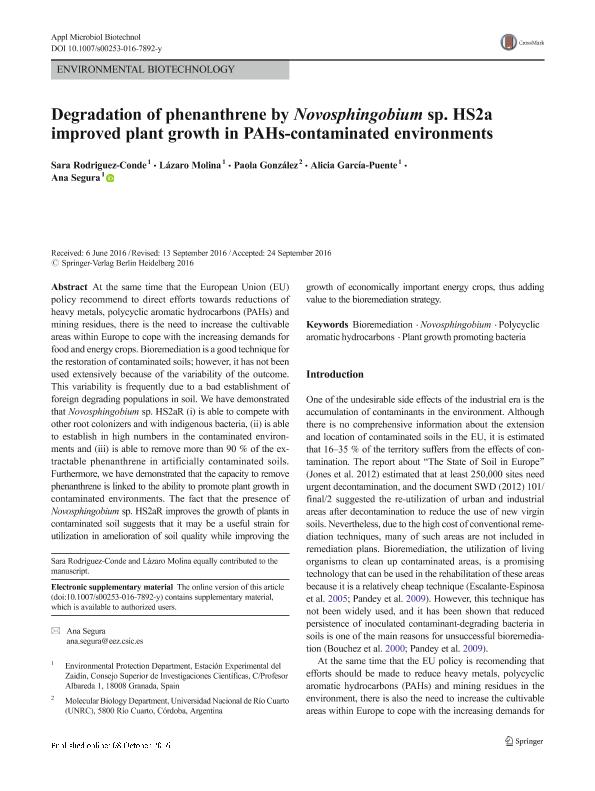Mostrar el registro sencillo del ítem
dc.contributor.author
Rodriguez Conde, Sara
dc.contributor.author
Molina, Lázaro
dc.contributor.author
González, Paola Solange

dc.contributor.author
García Puente, Alicia
dc.contributor.author
Segura, Ana
dc.date.available
2022-12-01T14:53:56Z
dc.date.issued
2016-09
dc.identifier.citation
Rodriguez Conde, Sara; Molina, Lázaro; González, Paola Solange; García Puente, Alicia; Segura, Ana; Degradation of phenanthrene by Novosphingobium sp. HS2a improved plant growth in PAHs-contaminated environments; Springer; Applied Microbiology and Biotechnology; 100; 24; 9-2016; 10627-10636
dc.identifier.issn
0175-7598
dc.identifier.uri
http://hdl.handle.net/11336/179809
dc.description.abstract
At the same time that the European Union (EU) policy recommend to direct efforts towards reductions of heavy metals, polycyclic aromatic hydrocarbons (PAHs) and mining residues, there is the need to increase the cultivable areas within Europe to cope with the increasing demands for food and energy crops. Bioremediation is a good technique for the restoration of contaminated soils; however, it has not been used extensively because of the variability of the outcome. This variability is frequently due to a bad establishment of foreign degrading populations in soil. We have demonstrated that Novosphingobium sp. HS2aR (i) is able to compete with other root colonizers and with indigenous bacteria, (ii) is able to establish in high numbers in the contaminated environments and (iii) is able to remove more than 90 % of the extractable phenanthrene in artificially contaminated soils. Furthermore, we have demonstrated that the capacity to remove phenanthrene is linked to the ability to promote plant growth in contaminated environments. The fact that the presence of Novosphingobium sp. HS2aR improves the growth of plants in contaminated soil suggests that it may be a useful strain for utilization in amelioration of soil quality while improving the growth of economically important energy crops, thus adding value to the bioremediation strategy.
dc.format
application/pdf
dc.language.iso
eng
dc.publisher
Springer

dc.rights
info:eu-repo/semantics/openAccess
dc.rights.uri
https://creativecommons.org/licenses/by-nc-sa/2.5/ar/
dc.subject
BIOREMEDIATION
dc.subject
NOVOSPHINGOBIUM
dc.subject
PLANT GROWTH PROMOTING BACTERIA
dc.subject
POLYCYCLIC AROMATIC HYDROCARBONS
dc.subject.classification
Biotecnología Medioambiental

dc.subject.classification
Biotecnología del Medio Ambiente

dc.subject.classification
INGENIERÍAS Y TECNOLOGÍAS

dc.title
Degradation of phenanthrene by Novosphingobium sp. HS2a improved plant growth in PAHs-contaminated environments
dc.type
info:eu-repo/semantics/article
dc.type
info:ar-repo/semantics/artículo
dc.type
info:eu-repo/semantics/publishedVersion
dc.date.updated
2022-12-01T14:18:42Z
dc.journal.volume
100
dc.journal.number
24
dc.journal.pagination
10627-10636
dc.journal.pais
Alemania

dc.journal.ciudad
Berlin
dc.description.fil
Fil: Rodriguez Conde, Sara. Consejo Superior de Investigaciones Científicas. Estación Experimental del Zaidín; España
dc.description.fil
Fil: Molina, Lázaro. Consejo Superior de Investigaciones Científicas. Estación Experimental del Zaidín; España
dc.description.fil
Fil: González, Paola Solange. Universidad Nacional de Río Cuarto. Facultad de Ciencias Exactas Fisicoquímicas y Naturales; Argentina. Centro de Investigaciones Cientificas ; Facultad de Ciencias Exactas Fisicas y Naturales ; Universidad Nacional de Cordoba;
dc.description.fil
Fil: García Puente, Alicia. Consejo Superior de Investigaciones Científicas. Estación Experimental del Zaidín; España
dc.description.fil
Fil: Segura, Ana. Consejo Superior de Investigaciones Científicas. Estación Experimental del Zaidín; España
dc.journal.title
Applied Microbiology and Biotechnology

dc.relation.alternativeid
info:eu-repo/semantics/altIdentifier/url/https://link.springer.com/article/10.1007/s00253-016-7892-y
dc.relation.alternativeid
info:eu-repo/semantics/altIdentifier/doi/http://dx.doi.org/10.1007/s00253-016-7892-y
Archivos asociados
